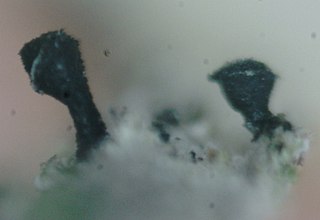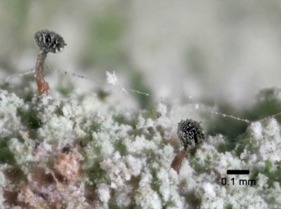
Chaenothecopsis is a genus of about 40 species of pin lichens in the family Mycocaliciaceae.
Echinoplaca pernambucensis is a species of crustose lichen in the family Gomphillaceae. It was described as new to science in 2011. It is found in the Atlantic Forest in Pernambuco, Brazil. This lichen is similar in appearance to Echinoplaca verrucifera, but lacks setae and contains gyrophoric, lecanoric, and subgyrophoric acids.

Lecanora muralis(Protoparmeliopsis muralis) is a waxy looking, pale yellowish green crustose lichen that usually grows in rosettes radiating from a center (placodioid) filled with disc-like yellowish-tan fruiting bodies (apothecia). It grows all over the world. It is extremely variable in its characteristics as a single taxon, and may represent a complex of species. The fruiting body parts have rims of tissue similar to that of the main nonfruiting body (thallus), which is called being lecanorine. It is paler and greener than L. mellea, and more yellow than L. sierrae. In California, it may be the most common member of the Lecanora genus found growing on rocks (saxicolous).

Calicium glaucellum is a crustose lichen that is found growing on trees throughout much of the world. The species is similar to Calicium abietinum.
Chaenothecopsis dibbleandersoniarum is a species of fungus in the family Mycocaliciaceae. It was described as new to science in 2003 by Steve Selva, from samples collected on Cape Breton Island, Nova Scotia, Canada. It has also been recorded in Maine. The fungus is lichenicolous, and grows as a parasite on the apothecia and thallus of the lichen Arthonia leucopellaea. It is named after Dr. Alison Dibble and Ms. Frances Anderson, both of whom independently brought the species to the attention of Selva.

Punctelia hypoleucites, commonly known as the southwestern speckled shield lichen, is a species of foliose (leafy) lichen in the family Parmeliaceae. First formally described by Finnish botanist William Nylander as a species of Parmelia, it was transferred to the genus Punctelia in 1982. The lichen is found in Africa, North America, and South America, where it grows on the bark of both hardwood and coniferous trees. Its greenish-grey thallus is covered with tiny white pseudocyphellae – minute holes in the thallus surface that facilitate gas exchange. Some macroscopic features that help distinguish this species from other related members of the genus include the presence and the structure of the apothecia, the absence of asexual surface propagules, and the light brown color of the thallus undersurface. Chemically, the presence of lecanoric acid in the medulla and atranorin in the cortex help distinguish it from lookalikes.

Punctelia bolliana, the eastern speckled shield lichen, is a species of foliose lichen in the family Parmeliaceae. It is found in North America, with a distribution extending from the Canadian province of Ontario south to the central and northeastern United States and Mexico. It grows on the bark of both deciduous trees and coniferous trees. The combination of characteristics that distinguishes this species from others in genus Punctelia are the absence of the vegetative propagules isidia and soralia, a pale brown lower thallus surface, and the presence of the secondary chemical protolichesterinic acid in the medulla.
Stenocybe tropica is a species of corticolous (bark-dwelling) pin lichen in the family Mycocaliciaceae. Found in Brazil, it was formally described as a new species in 2015 by Dutch lichenologist André Aptroot. The type specimen was collected in Praia de Peruíbe near Itanhaém; here it was found growing on mangrove tree bark. The apothecia are black with a cylindrical to club-shaped head (capitulum) about 0.3 mm in diameter and up to 0.5 mm high. The stalk holding the capitulum is glossy black, up to 0.8 mm tall and about 0.15 mm wide. Its ascospores are dark brown in colour, more or less fusiform (spindle-shaped) with 3 septa, measuring 46–71 by 14–21 μm with mostly pointed tips. No lichen products were detected in the lichen.
Coenogonium lueckingii is a species of corticolous (bark-dwelling), crustose lichen in the family Coenogoniaceae. It is known to occur in a couple of locations in South Korea, where it grows on the bark of trees in humid locations.
Chaenothecopsis penningtonensis is a resinicolous fungus found on Picea mariana bark flakes. Found in Minnesota and Wisconsin, Chaenothecopsis penningtonensis is newly introduced in 2020 by ecologists Otto Gockman and Steven Selva. As of 2022, this species have also been observed in Alberta, Canada by ecologist Jose Maloles.
Enterographa rotundata is a species of corticolous (bark-dwelling) crustose lichen in the family Roccellaceae. This species was discovered in Brazil, growing on the smooth bark of trees in the Brazilian Caatinga forest. It has round apothecia, a feature that sets it apart from most of its kind.
Waynea algarvensis is a rare species of corticolous (bark-dwelling) squamulose lichen in the family Ramalinaceae. Native to the Algarve province in Portugal, it was formally described as a new species in 2012. Closely related to Waynea cretica, this lichen is characterized by its minute thallus parts and fusiform (spindle-shaped) ascospores. Found primarily on olive trees, this lichen forms part of understudied epiphytic communities in the region.
Cratiria sorediata is a species of corticolous (bark-dwelling), crustose lichen in the family Caliciaceae. It was first described as a new species in 2009. The type specimen was collected from Aldabra in the Seychelles.
Pyrrhospora palmicola is a species of corticolous (bark-dwelling), crustose lichen in the family Lecanoraceae. It has a yellow thallus with rounded to irregular apothecia with pale brown or black discs. The lichen is found in Mato Grosso, Brazil, and the Seychelles.
Coenogonium flammeum is a species of corticolous (bark-dwelling), crustose lichen in the family Harpidiaceae. It is found in Argentina.
Rinodina maronisidiata is a species of corticolous (bark-dwelling), crustose lichen in the family Physciaceae, first described in 2018. Found at high altitudes in the Venezuelan Andes, it is characterised by its unique isidia-covered thallus and specific ascospore morphology.
Leptogium cookii is a species of corticolous (bark-dwelling), foliose lichen in the family Collemataceae. It is found in northwestern North America.

Chaenothecopsis kilimanjaroensis is a species of lichenicolous (lichen-dwelling) pin lichen in the family Mycocaliciaceae. Found in the cloud forests of Tanzania, it was described as a new species in 2019. These tiny lichens have a short stalk, which can be either single or formed in aggregates on the same thallus. The stalks are medium brown at the base and become translucent in water. This species has unique spores, which contain a single septum, are arranged in a single row in the ascus, and have a surface ornamented with elongated, blister-like structures.
Marchantiana occidentalis is a species of corticolous and saxicolous, crustose lichen in the family Teloschistaceae. It is found in Western Australia, usually as an inhabitant of dry twigs, bark, or wood of various plant species, but occasionally on granite rock outcrops. It forms a well-developed thallus, shiny and composed of tiny dark greenish to brown areoles, with sizes typically ranging from 5–15 mm, though larger aggregations are possible. It features numerous rounded apothecia scattered across its surface, varying in form and colour, with a distinct margin and disc.
Buellia bahiana is a crustose-type lichen species that frequently grows on the bark and wood of trees found in coastal and inland forest habitats. This lichen species exhibits a broad geographic distribution, being documented in various pantropical and subtropical regions around the world. Specific areas where Buellia bahiana has been recorded include parts of Australia, Africa, North America, Central America, South America, and several Pacific Island chains.





